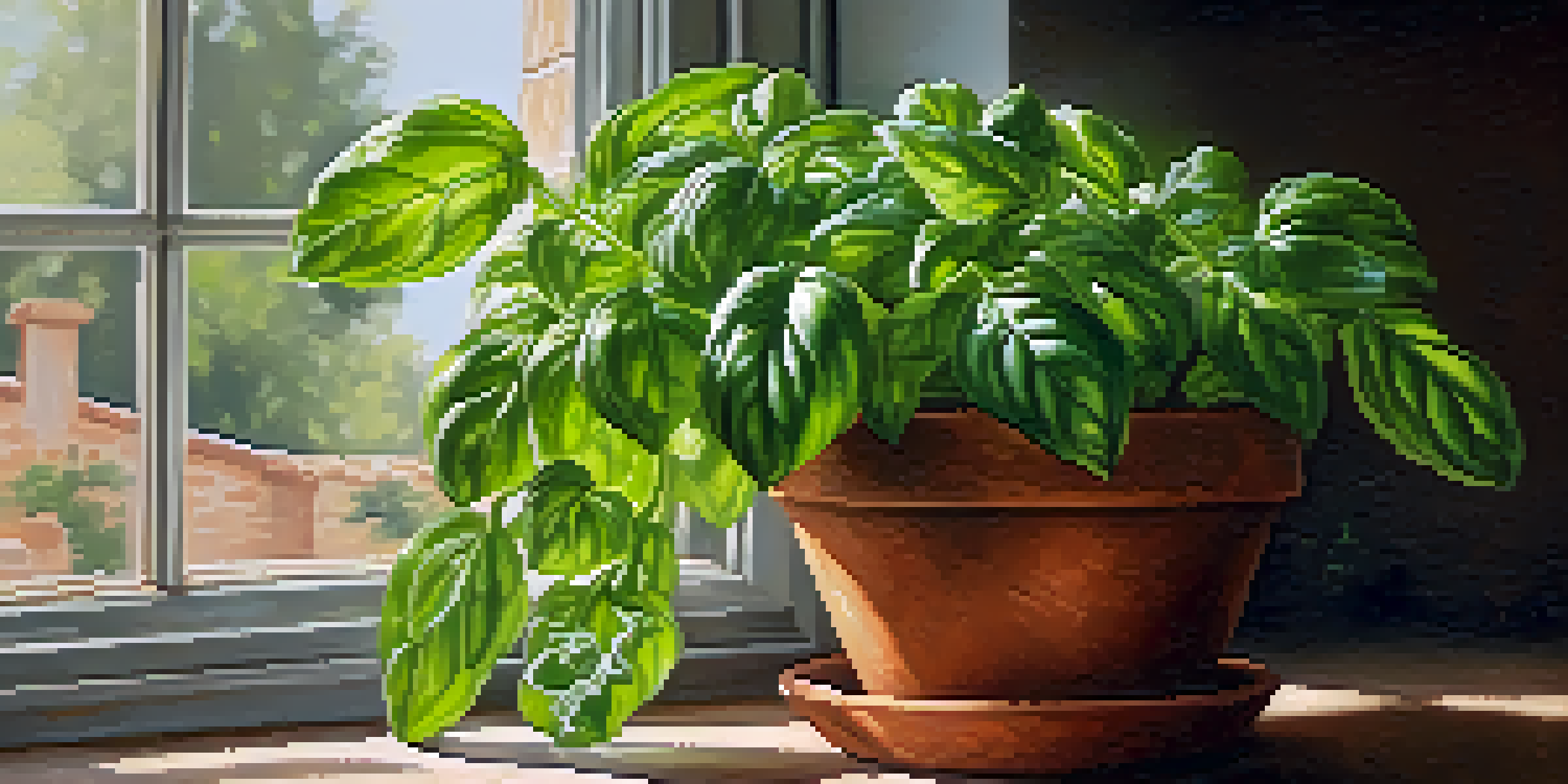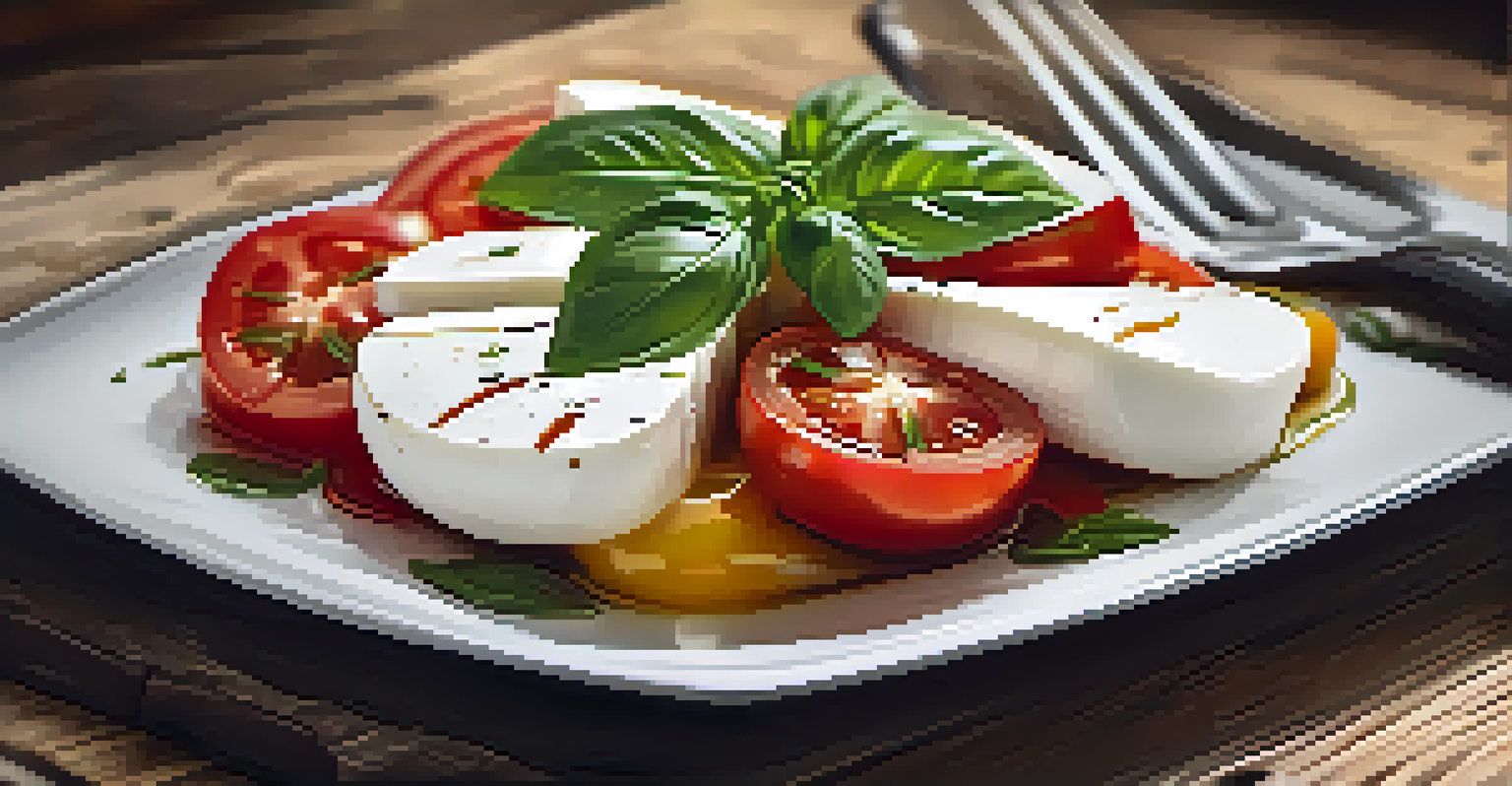Growing Basil: A Guide to Cultivating and Using This Herb

Understanding Basil: Types and Varieties to Consider
Basil is a beloved herb that comes in various types, each offering unique flavors and uses. Common varieties include Sweet Basil, Thai Basil, and Genovese Basil, making it easy to find one that suits your culinary needs. Understanding the differences can help you select the right type for your dishes, whether it's a Caprese salad or a fragrant Thai curry.
Herbs are the friend of the cook, and basil is the friendliest of them all.
Sweet Basil is the most popular variety, often used in Italian cuisine, with its aromatic and slightly peppery taste. On the other hand, Thai Basil has a more pronounced anise flavor, perfect for Asian dishes. By experimenting with different types, you can enhance your meals and discover new flavor profiles.
Choosing the right basil variety not only enriches your cooking but also adds visual appeal to your garden. With vibrant green leaves and delicate flowers, basil plants can be a beautiful addition to your home or patio. So, explore the world of basil to find your favorite!
Essential Growing Conditions for Healthy Basil Plants
To grow luscious basil, you need to provide the right conditions. Basil thrives in warm weather, so it's best to plant it after the last frost, ideally when the soil temperature reaches about 70°F. A sunny spot with at least six hours of direct sunlight each day will help your plants flourish.

Soil quality is equally important; basil prefers well-draining soil rich in organic matter. You can enhance your soil by mixing in compost or well-rotted manure, which will nourish your plants. Remember, avoiding waterlogged soil is crucial, as basil roots don’t like sitting in water.
Basil Varieties Enhance Flavor
Different types of basil, like Sweet and Thai Basil, offer unique flavors that can elevate a variety of dishes.
Additionally, spacing your plants correctly allows for good air circulation, preventing diseases. A good rule of thumb is to plant them about 12 inches apart. With the right conditions, your basil plants will grow vigorous and lush, ready for harvest.
Planting and Propagating Basil: A Step-by-Step Guide
Planting basil can be a rewarding experience. You can start from seeds, which requires sowing them about a quarter-inch deep in soil, or from seedlings, which can be purchased at garden centers. If you're feeling adventurous, you can also propagate basil from cuttings, making it easy to expand your garden without much expense.
The greatest flavors come from the freshest ingredients, and nothing is fresher than your own homegrown basil.
When sowing seeds, it's essential to keep the soil consistently moist until they germinate, usually within 5 to 10 days. Once seedlings emerge, thin them out to ensure healthy growth. If you’re using cuttings, simply place them in water until roots develop, then transfer them to soil.
Finally, be patient and attentive as your plants grow. Regularly check for signs of pests or diseases, and provide the necessary care to keep your basil healthy. This nurturing process is key to achieving a bountiful harvest later on.
Caring for Your Basil: Watering, Fertilizing, and Pruning
Caring for basil requires a balance of watering, fertilizing, and pruning. Basil prefers consistently moist soil, so water it regularly but avoid overwatering, which can lead to root rot. A good practice is to water deeply once the top inch of soil feels dry to the touch.
Fertilizing your basil every four to six weeks with a balanced fertilizer can help promote lush growth. Organic options, like fish emulsion or liquid seaweed, are great choices for those looking to keep things natural. Just remember to follow the recommended application rates to avoid overwhelming your plants.
Optimal Conditions for Growth
Basil thrives in warm, sunny conditions with well-draining soil, making proper care essential for a successful harvest.
Pruning is another essential aspect of basil care. Regularly pinching off the tips of the stems encourages bushier growth and prevents your plants from flowering too early, which can lead to a bitter taste. With proper care, you’ll have vibrant basil ready for your culinary creations.
Harvesting Basil: When and How to Collect Leaves
Harvesting basil is one of the most rewarding parts of growing this herb. You can start harvesting once your plants are about six inches tall, which typically takes around 6 to 8 weeks after planting. The best time to harvest is in the morning when the oils in the leaves are most concentrated, providing maximum flavor.
To harvest, simply pinch or cut off the leaves from the top of the plant, leaving at least a few sets of leaves on each stem. This encourages further growth and ensures that your plants remain healthy and vigorous. Avoid removing more than one-third of the plant at a time to prevent stress.
If you notice flowers beginning to form, it's a good idea to remove them promptly. Flowering can alter the flavor of basil, making it more bitter. With careful harvesting, you can enjoy fresh basil throughout the growing season!
Using Basil in the Kitchen: Culinary Ideas and Tips
Basil is a versatile herb that can elevate countless dishes, adding a fresh, aromatic flavor. Whether you're making pesto, tossing it into a salad, or using it as a garnish for soups and sauces, the possibilities are endless. Fresh basil is best used toward the end of the cooking process to maintain its vibrant flavor.
For a simple yet delicious option, try making a classic Caprese salad with fresh mozzarella, tomatoes, and a generous handful of basil leaves. Drizzle with balsamic vinegar and olive oil for a refreshing dish that's perfect for summer gatherings. You can also blend basil into smoothies for a unique twist.
Harvesting for Maximum Flavor
Harvesting basil in the morning and avoiding excessive removal of leaves ensures vibrant flavor and encourages healthy growth.
Don’t forget about preserving your basil! You can freeze chopped basil in ice cube trays with olive oil or make homemade pesto to enjoy throughout the year. This way, you can savor the fresh taste of basil even when it's out of season.
Common Problems and Solutions When Growing Basil
Like any plant, basil can face its share of challenges. Common issues include pests like aphids and spider mites, which can damage your plants if left unchecked. Regularly inspecting your basil can help you catch these problems early, allowing for timely treatment with organic insecticidal soap or neem oil.
Another concern is fungal diseases, often caused by overwatering or poor air circulation. To minimize these risks, ensure your basil is well-spaced and water it at the base rather than from above, keeping the leaves dry. If you notice any signs of disease, promptly remove affected leaves to prevent spreading.

Lastly, if your basil starts to bolt or flower, it's a sign that the plant is stressed, often due to high temperatures or lack of nutrients. To remedy this, you can move your basil to a cooler spot and ensure it's getting adequate fertilizer. With vigilance and care, your basil can thrive despite the hurdles.